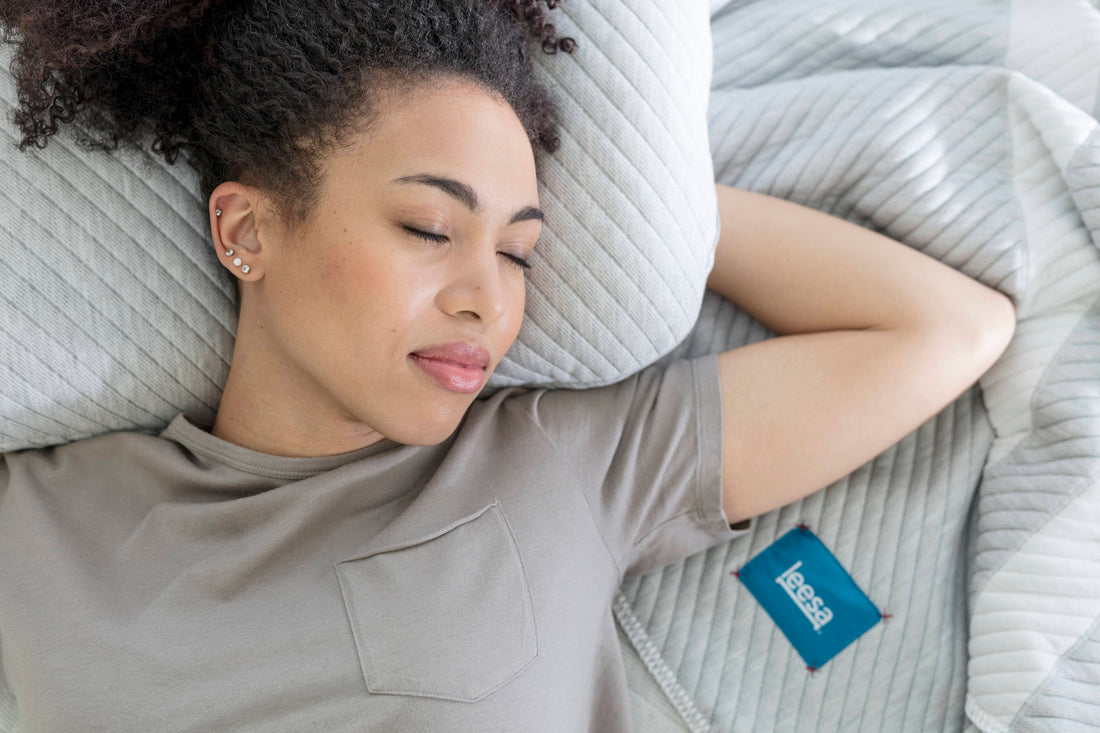Everyone is different—from your favorite color to the foods you like to your hobbies. So, when it comes to sleep, it’s no surprise that people prefer different sleeping positions and sleep settings. Whether you’re a side, stomach or back sleeper, there is probably a certain position that you’re most comfortable in when you sleep. Do you like to sleep on your side with a pillow between your legs? Maybe you prefer sleeping on your stomach with your arms and legs outstretched. The way you’re most comfortable when falling asleep depends on your own personal preference.
Only about 10% of people say they prefer to sleep on their backs (side sleeping is the most popular position). However, many experts say that sleeping on your back is the best position for deep, restful sleep.
Benefits to Sleeping on Your Back
- By sleeping on your back, your head, neck, and spine stay aligned in a neutral position, reducing pressure in those spots. Less pressure while you sleep means less pain when you wake up.
- Ever wake up with creases and marks on your face and body from your pillow, blanket or hand? Cute, right? Not exactly. Plus, experts have found that people who sleep on their side or stomach, and therefore, their faces, often have deeper and more prominent wrinkles. If you’re super consistent about sleeping in a specific side or on your stomach, a sleep expert or dermatologist may even be able to tell what side you favor just by looking at your skin.
- Sleeping on your back can also help if you suffer from acid reflux (especially if you usually eat close to bedtime). If you properly support your head so that it’s elevated slightly above your stomach, you can reduce acid reflux symptoms while you sleep.
Train Yourself to Sleep on Your Back
It can be hard to change your sleeping position, especially if you’ve been sleeping in the same position for a long time. You may have to do a little sleep training if you want to start sleeping on your back. (After all, experts say it takes about 21 days to form a habit.)
Just remember that for good rest, it's important to sleep in a position that’s comfortable for you. It’s more important to get deep, restful sleep than it is to sleep in a specific position. However, if you want to become a back sleeper, here are some training tips:
- Start by lying flat on your bed (obviously). Try resting with your arms down by your sides, raise them above your head in a goal post position or stretch them out straight on either side of you.
- Elevate your upper body slightly, either with an adjustable bed or an incline of pillows. This may make sleeping on your back more comfortable so that you stay on your back while you snooze.
- Try putting a pillow or rolled-up towel under your knees to alleviate pressure on your spine.
- Create a barrier of pillows on either side of you. This can prevent you from rolling over and help you feel more protected and secure while you sleep on your back. Try a pillow on either side of you to rest your arms on. This can help you feel cradled.
Problems and Solutions Associated with Back Sleeping
Problem: Sleeping on your back may aggravate symptoms of sleep apnea. Because of the way your tongue rests in your mouth when you sleep on your back, your airway may get blocked.
Solution: Prop your head up so it's higher than your body. If your head is elevated above your body, the angle may help relieve these symptoms.
Problem: Sleeping on your back may worsen snoring.
Solution: The same solution as above (elevating your head) may help alleviate snoring by opening your airway while you sleep. You may also benefit from an adjustable bed. Not only can an adjustable bed be great for lounging around and movie marathons, but it can also help you sleep on your back comfortably. Elevate your upper body slightly to relieve symptoms of sleep apnea and snoring. (Plus, head elevation can help you sleep when you have a cold.)
Problem: Many people complain that sleeping on their backs causes hip and back pain. The pressure on your hips and back while you sleep on your back can be intense, but there are some ways you can alleviate that pain.
Solution: Put a pillow or rolled-up towel under your knees. The angle this creates helps round your spine and relieve some of the pressure while you sleep. You can also try stretching before bed. If you loosen up your hip flexors at night, you’ll reduce the pressure on your spine.
Problem: If you’re pregnant, you should avoid sleeping on your back, especially in your second and third trimesters. Sleeping on your back can decrease blood circulation in your body, which isn’t good for your growing baby.
Solution: Because of the decreased circulation, your body will naturally wake you up if you happen to roll onto your back while you’re asleep. If you’re pregnant, you should try sleeping on your side.
Do you Really Need to Sleep on Your Back?
Of course, if sleeping on your back is too uncomfortable or is costing you good rest, the solution is simple: don’t sleep on your back. But if you can fall asleep on your back and stay asleep comfortably, it is the most beneficial sleeping position.
Regardless of your preferred sleeping position, you need a good mattress. We offer two great mattresses, made for all body types and sleeping positions. The Leesa mattress is our all-foam mattress, now new and improved, featuring enhanced pressure relief and cooling technology to keep you cool all night. Our Leesa Hybrid mattress features premium foams and springs, offering enhanced pressure relief, edge-to-edge support and a luxurious sleep experience.
